
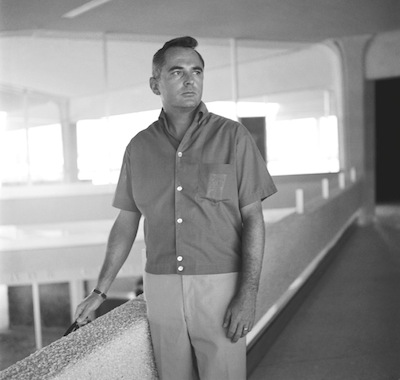 When the architect Donald Wexler passed away this summer, he left a city full of midcentury structures that permanently changed the world’s perceptions of Palm Springs. Wexler, who never ceased to serve as a local resource for both colleagues and enthusiasts, died at home on June 26 at the age of 89.
When the architect Donald Wexler passed away this summer, he left a city full of midcentury structures that permanently changed the world’s perceptions of Palm Springs. Wexler, who never ceased to serve as a local resource for both colleagues and enthusiasts, died at home on June 26 at the age of 89.
In 2011, Palm Springs Art Museum recognized his 50-year career with a retrospective titled “Steel and Shade: The Architecture of Donald Wexler.” Right up through his final years, the architect who pioneered affordable steel houses, zigzagging caterpillar rooflines, and statement-making commercial buildings consulted with renovators, homeowners, and fellow architects who sought to preserve his work and update it with the utmost respect for his original intentions.
“Don and I collaborated on projects both big and small, and never once did I have the sense that his interests, passion, and skills were from another era,” the architect Lance O’Donnell remarked. “Rather, his modernist training served him as well in the 1940s as it did in 2015.”
Wexler is part of an elite circle of celebrated midcentury architects who have become synonymous with Greater Palm Springs’ architecture, its aesthetic, and even its tourism; their epic careers seem to continue even without their physical presence. They live in the evocative spaces, the angular late-day shadows, and the mountains’ strategic reflections on floor-to-ceiling walls of glass.
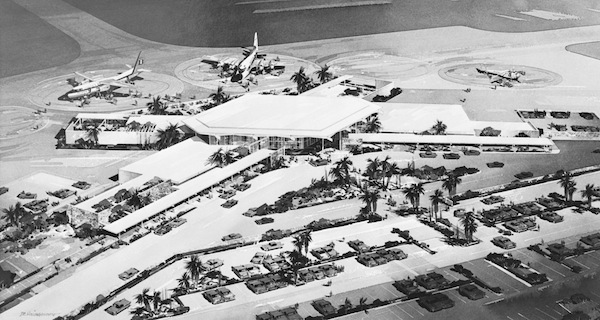
photo courtesy of palm springs life archives
When Donald Wexler took on the design of the main terminal of the Palm Springs International Airport, he envisioned it as a dramatic point of entry. According to The New York Times, “with 27-foot-tall windows looking onto Mount San Jacinto, it would express the city’s identity as a desert oasis.”
Midwestern No More
Born in South Dakota in 1926 and raised in Minneapolis, Wexler left for Los Angeles once he earned a degree in architecture from the University of Minnesota. In L.A., Wexler landed a coveted position working under the desert modernist Richard Neutra, of Kaufmann House fame. They were “great years,” Wexler said.
Drawn in by the resort lifestyle and an opportunity to work with William Cody on Tamarisk Country Club, Wexler planted firm roots in early-1950s Palm Springs. Rustic and simple then, it was a place that struck him as a small, friendly, affordable community, where families pool-hopped and played volleyball and stars walked down Palm Canyon without a care in the world. Wexler found it ideal for raising his three sons and an easy place to meet people and drum up business with his eventual partner, Richard Harrison.
Since 1966, Wexler’s talent has made a bold first impression on visitors flying in to Palm Springs International Airport. Credited with bringing the jet age to the region, Wexler chose soaring glass panels to stand like gentle sentinels across the front of the main terminal.

Photo courtesy of palm springs life archives
Donald Wexler's first impression on the desert was the Palm Springs International Airport.
Known widely as the “Man of Steel,” Wexler secured his superhero nickname from innovative steel-frame designs with prefabricated components. These play out in a number of commercial buildings and a handful of completed homes. The seven steel houses Wexler designed for the Alexander Construction Company in 1961 and 1962 are Palm Springs Class I Historic Sites. Tucked into the Racquet Club Estates neighborhood, they are popular stops on the modernism tours. Tough as nails in a harsh climate, these prized homes epitomize his preference for permanent, inorganic materials.
As an exclamation point to his work of the ’60s, Wexler teamed up on a final steel house in 2001. The Sanders/Krizman Residence by WWCOT/Wexler stands as a modern testament to the timeless attraction of steel, conceived 55 years after Wexler’s own former Palm Springs family home, which happens to sit next door.
“If the price of steel hadn’t increased, you would probably see thousands of steel houses instead of the few half dozen he was able to build,” said Peter Moruzzi, an architectural historian and founder of the Palm Springs Modern Committee, in the 2009 documentary film Journeyman Architect: The Life and Work of Donald Wexler. “Don really understood what was unique about the desert and designed for it. And that is a lesson that architects are learning today and will continue to learn from.”

Photo courtesy of palm springs life archives
Donald Wexler studying blueprints in his office in 1966.
Making His Mark
Wexler served as architect on many local homes for developers, interspersed with some custom work — including Dinah Shore’s residence, a home for Sue and Alan Ladd, and one for Bob Higgins that eventually became Kirk Douglas’ house. Both on his own and with Harrison, he designed livable condominium and apartment complexes. Beyond the 40 Polynesian-themed units at the Royal Hawaiian Estates, designated as the city’s first residential historic district in 2010, there are Sagewood Condominiums, Twin Springs Condominiums, and the Rose Garden in Palm Springs, as well as Rancho Estates and Tamarisk Court in Rancho Mirage. In 2001, steel-and-glass entry gates opened onto four new-construction homes at Wexler’s Tropicana project in Palm Springs.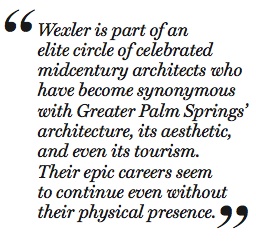
On a much larger scale are his civic and commercial endeavors, from the city’s police department, jail, and many area schools, to the Larson Justice Center in Indio, the Merrill Lynch Building, and Canyon Country Club (now Indian Canyons Golf Resort) in Palm Springs, and the original Palm Springs Spa Bath House. The stinging absence of the Spa Resort Casino’s dramatic shaded walkway remains a poignant reminder that even beloved landmarks are subject to undeserved demolition.
Eric Wills, from the National Trust for Historic Preservation, reported in 2008 that Wexler considered the midcentury era to be the golden age of architecture in Palm Springs. “We had no fear,” Wexler told Wills. “We played around with tilt-up and post-tension and prestretched and every type of construction there was. Nobody was worried about, ‘Are we going to be sued?’ Or, ‘We’ve got to cover our fanny.’”

photo courtesy of the palm springs art museum
The home Donald Wexler built for Dinah Shore was bought last year by Leonardo DiCaprio for $5.2 million.
To Wexler’s own surprise, he achieved the status of an architectural superstar. In addition to being a frequent subject of books and magazines over the past decade, Wexler collected a star on the Palm Springs Walk of Stars, dedicated in 2008.
Three years later, the Palm Springs Preservation Foundation organized “Wexler Weekend” to coincide with his 84th birthday. The three-day extravaganza of Wexler-designed house tours, evening cocktail parties, and much ado about Wexler included his granddaughters singing “Happy Birthday, Mr. Architect” during a Champagne jazz brunch at Indian Canyons Golf Resort, a screening of Journeyman Architect on opening night at Camelot Theatre, and a signing of a 60-page tribute journal. Multiple events and tours during Modernism Week offer an annual chance to get to know Wexler, whose work holds its own among the 80-plus properties highlighted in ModCom’s A Map of Modern Palm Springs. One of them, Dinah Shore’s six-bedroom home in Old Las Palmas, sold to Leonardo DiCaprio for $5.2 million in February 2014. At 7,022 square feet, it may be the most expensive tennis estate to feature a carport.
This past March, one of the seven modular steel-and-glass houses Wexler designed with Harrison added its address to the National Register of Historic Places — a first among the myriad of midcentury structures in Palm Springs. The home’s owner, Brian McGuire, had made it a personal goal to obtain the historic status during Wexler’s lifetime. “It’s a home, it’s a hobby, it’s a trophy, it’s a toy,” McGuire has said in praise of his steel house. “I just love it. Thank you, Don.”
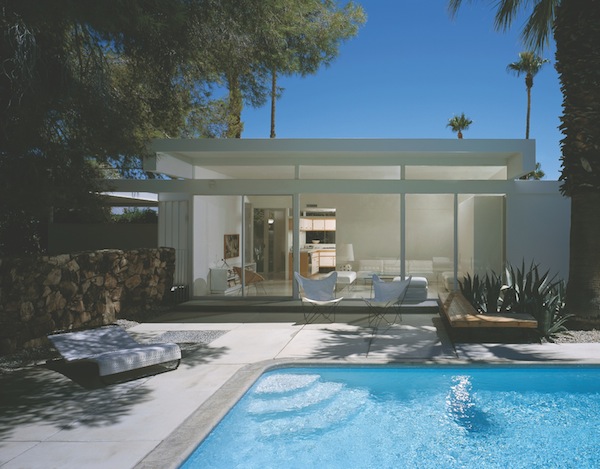
photo courtesy of the palm springs art museum
Donald Wexler and Richard Harrison’s steel and glass strucutres were meant to be housing that could be erected in 30 days.
Grand Impact, Modest—Mindset
Only a day spent immersed in the vast archives of Wexler’s work housed at the Cal Poly Pomona College of Environmental Design might comprehensively reveal the cultural impact of his designs.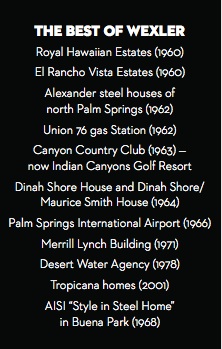
“My impression is that he took great pride in his work as a practical builder and craftsman as much as an artistic creator,” says the writer Morris Newman, who interviewed Wexler in 2011 for a Palm Springs Life profile entitled “The Quiet Elegance of Donald Wexler.” “I think he liked the idea of rational buildings that were built in an intelligent and economical way. He was also open to new ideas and new technologies. Palm Springs has lost one of its modernist originals.”The president of the Palm Springs Preservation Foundation, Erik Rosenow, and his wife, Ashley, were led in 2009 to buy a home in El Rancho Vista Estates, a tract of 70 Wexler & Harrison homes built circa 1960.
“Moving into the neighborhood, it was exciting to see the sense of community and pride our neighbors had in being stewards of these houses,” he recalls. “Over the last several years this sense of community has continued to grow, and we’ve celebrated by hosting several annual neighborhood tours during Modernism Week. It was always great to have Don visit and get the chance to show him our homes.”
Wexler seemed to experience a range of emotions about his acclaim, from honor to amusement to befuddlement. In 2011, his son Gary drove him through El Rancho Vista Estates in anticipation of Wexler Weekend, after which he recounted that his dad, unlike the homeowners, still didn’t quite understand what all the fuss was about.
“He was very humble,” says the real estate agent and renovator Chris Menrad, who owns an Alexander home and collaborated with Wexler on several renovations of his designs. “He always said that when he was working on his projects he was just doing his job — except that by doing his job he was creating art.”
Though he worked with Frank Sinatra and Walt Disney World, Wexler’s straightforward modesty is repeatedly mentioned by friends and associates.
“He always emphasized how his projects were a team effort between himself, his colleagues, his clients, and consultants, and that the sum was worth more than just one individual,” says Regina Basterrechea, the office manager at o2 Architecture. “He loved the process of creating great architecture, and it was fun to watch him collaborate with Lance [O’Donnell] and younger associates in our office on various projects. We all learned a lot about how to be better people and better designers from Don.”

photo by mark davidson
Not long ago, Donald Wexler toured the airport. Even today, it feels new and cutting edge.
What He Said
In his own words, Wexler kept it simple. “One of my biggest goals was to stay small and keep busy,” he said in Journeyman Architect. “That’s quite a juggling act for an architect. I cannot remember a design being turned down by a client.” Clients loved his approach, try as Wexler might to avoid defining it. “I don’t know what the right word for the style was — whether it was contemporary, modern, international. I hate to put a name on it,” he continued. “What we were basically doing was working with a program, a budget, the materials that were available, and especially with our elements here. The climate controlled much of what we did.”
Palm Springs’ leading architects are still following the techniques for mastering the elements that originated with their midcentury predecessors. O’Donnell remembers the day Wexler stepped into their Oasis Building office suite when he was a partner in the firm O’Donnell + Escalante Architects. “The first thing he said was, ‘I like what you’ve done with Stew’s office.’ We knew well that our suite was the former office of Williams, Williams and Williams Architects, but what I didn’t know was what good friends Don and E. Stewart Williams were,” he says. “Learning that all of Palm Springs’ pioneering modernist architects were friends and colleagues was one of the many revelations I had on my first day with Don.”

photo courtesy of palm springs life archives
After six months in Palm Springs, this is where the architect decided he wanted to spend his life.
Even during his life, “Wexler” was among the names murmured with reverence like that of a president, couturier, or legendary rock star. He and his contemporaries, including E. Stewart Williams, William F. ‘Bill’ Cody, John Lautner, Albert Frey, his former boss Richard Neutra, and William Krisel, who is currently an honorary board member of the Palm Springs Preservation Foundation, have added immeasurably to the area’s ongoing allure.
“It’s a draw; it’s what our city is about,” said Ginny Foat, Palm Springs City Council member, in 2011. “And Don’s played a big part in that.”
Those with an appreciation for the midcentury visionaries’ deliberate use of line and space continue to visit, buy property, and relocate to Palm Springs to enjoy a daily relationship with the architecture. Visitors and transplants come not solely to live in a “designer” home, but also to drive by some of the area’s finest-looking banks, schools, hotels, shopping centers, and public buildings expressing the architectural flavors of the times.
“His work is highly important in the architectural fabric of Palm Springs,” Rosenow says of Wexler. “And we must ensure that it continues to be so for generations to come.”
Yes, we must. Because in our minds, Palm Springs has its own “skyline,” never viewed in one fell swoop like a Manhattan’s or San Francisco’s. We take the liberty of lining up Wexler’s folded metal rooflines, sun-reducing angles, and modernist details into one mental picture that defines our small cityscape. It’s a place forever on the map. And for every coming and going through the airport’s main terminal — once just a dreamy sketch of glass walls facing the San Jacintos — Wexler welcomes us to his home.